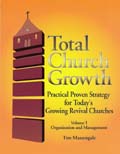The purpose of a tree (the church) is to bare fruit. That is the very essence of it’s existence. But it must be noted that the tree does not eat the fruit itself. Rather, the fruit is given away to a lost and hungry world. Within all fruit are seeds, capable of growing yet another tree. True, not every seed that falls will grow. Nevertheless, we understand that the more seeds that are sown, the more trees you will have.

By Tim Massengale
To View the Entire Article, Click Here
To Download the Entire Article Directly to Your Computer, Click Here
To View the Outline, Click Here
To View the PowerPoint, Click Here
What truly is the key to Apostolic church growth? Ask that question of fifty pastors or church leaders and you will most likely receive fifty assorted answers. Many would reply that prayer and fasting is the key. Others will place their hope in developing a loving Christian atmosphere. Some will claim that only strong, anointed preaching will bring results. Or perhaps a good outreach program of some kind. The list could be endless: Home Bible studies, attractive buildings, door knocking, mass crusades, revival meetings, and more. All have a good element of truth. But all can’t be the real, single key to growth. Is there such a thing?
Yes! There is a central element within all revivals since the Day of Pentecost. The common characteristic of all growing churches is people. God has chosen the vehicle of humankind to carry the Gospel truth. Without people, not only would there no one to bring the truth, but there is no one to receive it either.
Well, of course people make churches grow. That’s obvious!
But wait a minute. Stop and think. There are some very important implications to this most obvious of observations. It really isn’t things, like buses or buildings. It isn’t even actions, like preaching and prayer – although you will never have true revival and growth without them. It’s dedicated saints, believing God, spending time in prayer, willing to plant the Gospel seed, witnessing to friends, inviting family, teaching home Bible studies – that enables a church to see growth and revival. True evangelism is not a program, it is a result.
The church has been often paralleled to a mighty force of salesmen who are seeking people to “buy the truth and sell it not.” Any good salesman will tell you that the key to sales success is good contacts – people who are interested in what you have to offer. For a church, these are simply called “prospects.” A prospect is a non-Christian of whom one or more persons within your church knows in some way. They may be family, friend, work associates, acquaintances, or neighbors. They may know them casually or intimately. But regardless, there is some kind of personal relationship. All current research proves that, of those who accepted truth, the vast majority – over 90% – were contacted as the result of a relationship bridge. So it stands to reason that if a church wishes to grow, it is here that it should focus its evangelistic efforts. To grow, a church needs prospects.
What To Do With Prospects
You can find prospects everywhere. We will find them behind barriers of racial, social, and economic discrimination. We will find them behind barriers of prison, hospital, rest home, and ghetto – areas that many Christians seem reluctant to penetrate. Yet, somehow our attitudes must change. Like William Booth, we must also cry, “Some wish to live in the sound of chapel bell, but give me a rescue mission, ten yards from hell.” We must adopt the attitude of D. L. Moody when he wrote, “I see every person as though he had a huge “L” in the midst of his forehead. I consider him lost until I know he is saved.”
To View the Entire Article, Click Here
To Download the Entire Article Directly to Your Computer, Click Here
To View the Outline, Click Here



